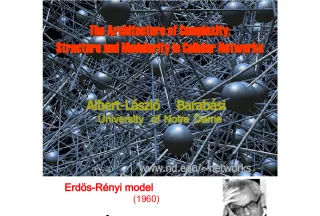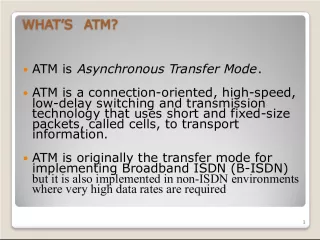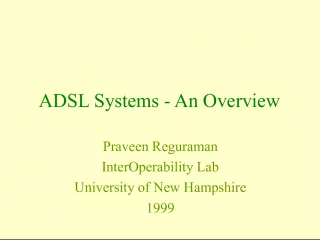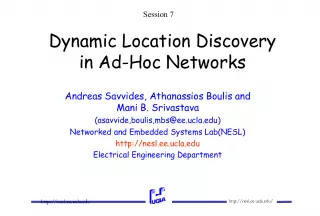"Wireless Networks: A comprehensive overview"
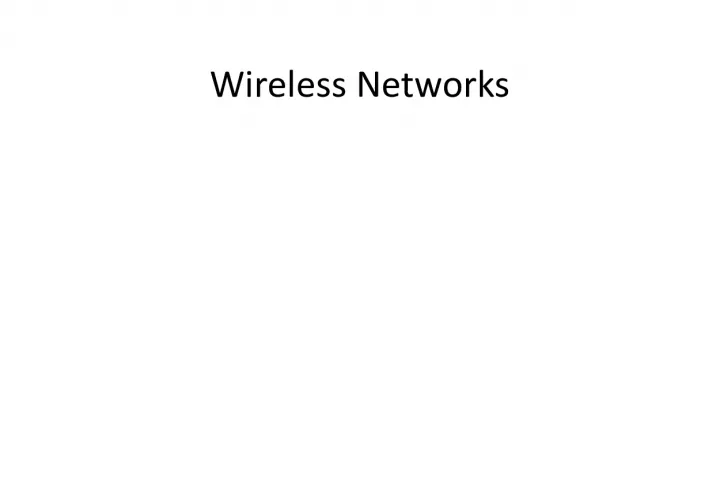

This presentation will cover the basics of wireless technology, including the IEEE 802.11 WLAN standards and how to secure wireless LANs. It will explain how a wireless local area network (WLAN) works, using radio waves as its carrier, and how it can give network connectivity to all users in a building or campus. While the backbone network usually uses cables, the last link with the users is wireless.
- Uploaded on | 1 Views
-
 henny
henny
About "Wireless Networks: A comprehensive overview"
PowerPoint presentation about '"Wireless Networks: A comprehensive overview"'. This presentation describes the topic on This presentation will cover the basics of wireless technology, including the IEEE 802.11 WLAN standards and how to secure wireless LANs. It will explain how a wireless local area network (WLAN) works, using radio waves as its carrier, and how it can give network connectivity to all users in a building or campus. While the backbone network usually uses cables, the last link with the users is wireless.. The key topics included in this slideshow are . Download this presentation absolutely free.
Presentation Transcript
2. Presentation Outline • Wireless Technology overview • The IEEE 802.11 WLAN Standards • Securing Wireless LANs
3. Wireless? • A wireless LAN or WLAN is a wireless local area network that uses radio waves as its carrier. • The last link with the users is wireless, to give a network connection to all users in a building or campus. • The backbone network usually uses cables
4. Common Topologies The wireless LAN connects to a wired LAN • There is a need of an access point that bridges wireless LAN traffic into the wired LAN. • The access point (AP) can also act as a repeater for wireless nodes, effectively doubling the maximum possible distance between nodes.
5. Common Topologies Complete Wireless Networks • The physical size of the network is determined by the maximum reliable propagation range of the radio signals. • Referred to as ad hoc networks • Are self-organizing networks without any centralized control • Suited for temporary situations such as meetings and conferences.
6. How do wireless LANs work? Wireless LANs operate in almost the same way as wired LANs, using the same networking protocols and supporting the most of the same applications.
7. How are WLANs Different? • They use specialized physical and data link protocols • They integrate into existing networks through access points which provide a bridging function • They let you stay connected as you roam from one coverage area to another • They have unique security considerations • They have specific interoperability requirements • They require different hardware • They offer performance that differs from wired LANs.
8. Physical and Data Link Layers Physical Layer: • The wireless NIC takes frames of data from the link layer, scrambles the data in a predetermined way, then uses the modified data stream to modulate a radio carrier signal . Data Link Layer: • Uses C arriers- S ense- M ultiple- A ccess with C ollision A voidance (CSMA/CA).
9. Integration With Existing Networks • Wireless Access Points (APs) - a small device that bridges wireless traffic to your network. • Most access points bridge wireless LANs into Ethernet networks, but Token-Ring options are available as well.
10. Integration With Existing Networks
11. Roaming • Users maintain a continuous connection as they roam from one physical area to another • Mobile nodes automatically register with the new access point. • Methods: DHCP, Mobile IP • IEEE 802.11 uses Fast Basic Service Set Transition (BSS FT)
12. Security • In theory, spread spectrum radio signals are inherently difficult to decipher without knowing the exact hopping sequences or direct sequence codes used • The IEEE 802.11 standard specified initial optional security called " W ired E quivalent P rivacy" (WEP) whose goal is that a wireless LAN offer privacy equivalent to that offered by a wired LAN. The standard also specifies optional authentication measures.
13. Interoperability • Before the IEEE 802.11 interoperability was based on cooperation between vendors. • IEEE 802.11 only standardizes the physical and medium access control layers. • Vendors must still work with each other to ensure their IEEE 802.11 implementations interoperate • Wireless Ethernet Compatibility Alliance (WECA) introduces the Wi-Fi Certification to ensure cross- vendor interoperability of 802.11b solutions
14. Hardware • PC Card, either with integral antenna or with external antenna/RF module. • ISA Card with external antenna connected by cable. • Handheld terminals • Access points
15. Hardware Cards Wireless Handheld Terminal Antennae (Semi Parabolic) Access Points Chips!
16. Performance • 802.11a offers speeds with a theoretically maximum rate of 54Mbps in the 5 GHz band • 802.11b offers speeds with a theoretically maximum rate of 11Mbps at in the 2.4 GHz spectrum band • 802.11g offers speeds for data rates of up to a theoretical maximum of 54 Mbps at 2.4 GHz.
17. What is 802.11? • A family of wireless LAN (WLAN) specifications developed by a working group at the Institute of Electrical and Electronic Engineers (IEEE) • Defines standard for WLANs using the following four technologies – Frequency Hopping Spread Spectrum (FHSS) – Direct Sequence Spread Spectrum (DSSS) – Infrared (IR) – Orthogonal Frequency Division Multiplexing (OFDM) • Versions: 802.11a, 802.11b, 802.11g, 802.11e, 802.11f, 802.11i…
18. 802.11 - Transmission • Most wireless LAN products operate in unlicensed radio bands – 2.4 GHz is most popular – Available in most parts of the world – No need for user licensing • Most wireless LANs use spread-spectrum radio – Resistant to interference, secure – Two popular methods • Frequency Hopping (FH) • Direct Sequence (DS)
19. Frequency Hopping Vs. Direct Sequence • FH systems use a radio carrier that “hops” from frequency to frequency in a pattern known to both transmitter and receiver – Easy to implement – Resistance to noise – Limited throughput (2-3 Mbps @ 2.4 GHz) • DS systems use a carrier that remains fixed to a specific frequency band. The data signal is spread onto a much larger range of frequencies (at a much lower power level) using a specific encoding scheme. – Much higher throughput than FH (11 Mbps) – Better range – Less resistant to noise (made up for by redundancy – it transmits at least 10 fully redundant copies of the original signal at the same time)
20. 802.11a • Employs Orthogonal Frequency Division Multiplexing (OFDM) – Offers higher bandwidth than that of 802.11b, DSSS (Direct Sequence Spread Spectrum) – 802.11a MAC (Media Access Control) is same as 802.11b • Operates in the 5 GHz range
21. 802.11a Advantages • Ultra-high spectrum efficiency – 5 GHz band is 300 MHz (vs. 83.5 MHz @ 2.4 GHz) – More data can travel over a smaller amount of bandwidth • High speed – Up to 54 Mbps • Less interference – Fewer products using the frequency • 2.4 GHz band shared by cordless phones, microwave ovens, Bluetooth, and WLANs
22. 802.11a Disadvantages • Standards and Interoperability – Standard not accepted worldwide – No interoperability certification available for 802.11a products – Not compatible or interoperable with 802.11b • Legal issues – License-free spectrum in 5 GHz band not available worldwide • Market – Beyond LAN-LAN bridging, there is limited interest for 5 GHz adoption
23. 802.11a Disadvantages • Cost – 2.4 GHz will still has >40% cost advantage • Range – At equivalent power, 5 GHz range will be ~50% of 2.4 GHz • Power consumption – Higher data rates and increased signal require more power • OFDM is less power-efficient then DSSS
24. 802.11a Applications • Building-to-building connections • Video, audio conferencing/streaming video, and audio • Large file transfers, such as engineering CAD drawings • Faster Web access and browsing • High worker density or high throughput scenarios – Numerous PCs running graphics-intensive applications
25. 802.11a Vs. 802.11b 802.11a vs. 802.11b 802.11a 802.11b Raw data rates Up to 54 Mbps (54, 48, 36, 24,18, 12 and 6 Mbps) Up to 11 Mbps (11, 5.5, 2, and 1 Mbps) Range 50 Meters 100 Meters Bandwidth UNII and ISM (5 GHz range) ISM (2.4000— 2.4835 GHz range) Modulation OFDM technology DSSS technology
26. 802.11g • 802.11g is a high-speed extension to 802.11b – Compatible with 802.11b – High speed up to 54 Mbps – 2.4 GHz (vs. 802.11a, 5 GHz) – Using ODFM for backward compatibility – Adaptive Rate Shifting
27. 802.11g Advantages • Provides higher speeds and higher capacity requirements for applications – Wireless Public Access • Compatible with existing 802.11b standard • Leverages Worldwide spectrum availability in 2.4 GHz • Likely to be less costly than 5 GHz alternatives • Provides easy migration for current users of 802.11b WLANs – Delivers backward support for existing 802.11b products • Provides path to even higher speeds in the future
28. 802.11e Introduces Quality of Service • Also know as P802.11 TGe • Purpose: – To enhance the 802.11 Medium Access Control (MAC) to improve and manage Quality of Service (QoS) • Cannot be supported in current chip design • Requires new radio chips – Can do basic QoS in MAC layer
29. 802.11f – Inter Access Point Protocol • Also know as P802.11 TGf • Purpose: – To develop a set of requirements for Inter-Access Point Protocol (IAPP), including operational and management aspects
30. 802.11b Security Features • Wired Equivalent Privacy ( WEP ) – A protocol to protect link-level data during wireless transmission between clients and access points. • Services: – Authentication : provides access control to the network by denying access to client stations that fail to authenticate properly. – Confidentiality : intends to prevent information compromise from casual eavesdropping – Integrity : prevents messages from being modified while in transit between the wireless client and the access point.
31. Authentication Means: • Based on cryptography • Non-cryptographic • Both are identity-based verification mechanisms (devices request access based on the SSID – Service Set Identifier of the wireless network).
32. Authentication
33. Privacy • WEP Uses RC4 symmetric key, stream cipher algorithm to generate a pseudo random data sequence. The stream is XORed with the data to be transmitted • Key sizes: 40bits to 128bits • Unfortunately, attacks have shown that the WEP approach for privacy is vulnerable to certain attack regardless of key size


